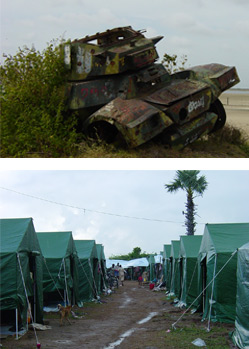In Sri Lanka’s North-Eastern provinces, traumatic experiences were already common prior to the Tsunami in December 2004. For two decades, thousands of people have been killed and many more were displaced as a result of conflict and violence in the country. The Liberation Tigers of Tamil Elam (LTTE) have been fighting for political autonomy, which resulted in ongoing conflict in the Northern and Eastern areas of the country. Civilians have become casualties of war; landmines and unexploded ordnance posed a constant threat; hospitals and schools have been destroyed; and the economy has been shattered.
Since the assassination of the rebel’s leader Velupillai Prabhakaran in May 2009, the violent conflict has ended. However, the Tamil civilian population, in particular the children, now have to face the widespread consequences of years of war. In the final phase of the most recent fights, about 300,000 Tamil Sri Lankans were transferred to camps in Vavuniya District (mostly former schools) and detained there against their will. Even though the Sri Lankan government had announced to resettle 80% of the IDPs by the end of 2009, at the end of February 2010, still 100.000 IDPs were living in the camps under extremely poor conditions.
In Sri Lanka’s North-Eastern provinces, traumatic experiences were already common prior to the Tsunami in December 2004. For two decades, thousands of people have been killed and many more were displaced as a result of conflict and violence in the country. The Liberation Tigers of Tamil Elam (LTTE) have been fighting for political autonomy, which resulted in ongoing conflict in the Northern and Eastern areas of the country. Civilians have become casualties of war; landmines and unexploded ordnance posed a constant threat; hospitals and schools have been destroyed; and the economy has been shattered.
Since the assassination of the rebel’s leader Velupillai Prabhakaran in May 2009, the violent conflict has ended. However, the Tamil civilian population, in particular the children, now have to face the widespread consequences of years of war. In the final phase of the most recent fights, about 300,000 Tamil Sri Lankans were transferred to camps in Vavuniya District (mostly former schools) and detained there against their will. Even though the Sri Lankan government had announced to resettle 80% of the IDPs by the end of 2009, at the end of February 2010, still 100.000 IDPs were living in the camps under extremely poor conditions.


